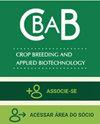一种更快速获得大豆新品种的简单而廉价的方法
IF 1.1
4区 农林科学
Q2 Agricultural and Biological Sciences
引用次数: 0
摘要
大豆(Glycine max L.)是世界四大作物之一。创造新的商业品种是一项长期的活动,从杂交设计开始到品种商业化注册需要7到8年的时间。快速世代提前(RGA)是一种控制影响植物生长的外部因素,以缩短播种到收获周期的技术。在本研究中,描述了一种优化的方法,可以使用便宜的设备,通过RGA加速大豆育种,并且易于育种者应用。我们的育种方法是在一个改良的冷库中安装荧光灯,提供12/24小时的光周期,温度设置为24°C。这种方法每年最多可培育5代,而不是目前在田间或温室条件下可能培育的1-2代。本文章由计算机程序翻译,如有差异,请以英文原文为准。
A simple and inexpensive procedure to more quickly obtain new varieties in soybean
Soybean (Glycine max L.) is one of the four most important crops in the world. The creation of new commercial varieties is a long-term activity that requires from seven to eight years from the beginning of the cross design up to registration for commercialization of cultivars. Rapid generation advance (RGA) is a technique that consists of controlling external factors that affect plant growth with the aim of shortening the sowing to harvest cycle. In the present study, an optimized method is described that can accelerate soybean breeding by means of RGA using inexpensive facilities and that can be easily applied by breeders. Our breeding method uses a modified cold storage chamber fitted with fluorescent lamps delivering a 12/24 h light photoperiod, while temperature is set at 24 °C. This method allows development of up to 5 generations per year instead of the 1-2 generations currently possible under field or greenhouse conditions.
求助全文
通过发布文献求助,成功后即可免费获取论文全文。
去求助
来源期刊
CiteScore
2.40
自引率
13.30%
发文量
25
审稿时长
6-12 weeks
期刊介绍:
The CBAB – CROP BREEDING AND APPLIED BIOTECHNOLOGY (ISSN 1984-7033) – is the official quarterly journal of the Brazilian Society of Plant Breeding, abbreviated CROP BREED APPL BIOTECHNOL.
It publishes original scientific articles, which contribute to the scientific and technological development of plant breeding and agriculture. Articles should be to do with basic and applied research on improvement of perennial and annual plants, within the fields of genetics, conservation of germplasm, biotechnology, genomics, cytogenetics, experimental statistics, seeds, food quality, biotic and abiotic stress, and correlated areas. The article must be unpublished. Simultaneous submitting to another periodical is ruled out. Authors are held solely responsible for the opinions and ideas expressed, which do not necessarily reflect the view of the Editorial board. However, the Editorial board reserves the right to suggest or ask for any modifications required. The journal adopts the Ithenticate software for identification of plagiarism. Complete or partial reproduction of articles is permitted, provided the source is cited. All content of the journal, except where identified, is licensed under a Creative Commons attribution-type BY. All articles are published free of charge. This is an open access journal.

 求助内容:
求助内容: 应助结果提醒方式:
应助结果提醒方式:


